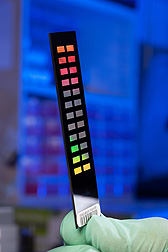Washington, DC, USA
February 18, 2014

This SoySNP50K iSelect SNP beadchip has 24 etched rectangles, which hold hundreds of thousands of microbeads, allowing detection of more than 50,000 bits of genetic information from a soybean DNA sample. Photo by Peggy Greb.
U.S. Department of Agriculture (USDA) researchers in Beltsville, Md. have developed a new tool to search for soybean genes that will make soybean plants more productive and better able to resist pests and diseases.
Scientists are constantly searching for genes to breed into soybeans that improve on disease resistance, yields, drought tolerance and other important characteristics. The tool was developed by Agricultural Research Service (ARS) scientists Perry Cregan, Qijian Song and Charles Quigley at the Soybean Genomics and Improvement Laboratory in Beltsville. Using the new tool, scientists can collect genetic information in three days that previously took weeks to gather.
The tool, called the SoySNP50K iSelect SNP BeadChip, is a glass chip about 3 inches long with an etched surface that holds thousands of DNA markers. The markers can be used to characterize the genomes of large numbers of soybean plants.
To create it, the researchers analyzed and compared the DNA of six cultivated and two wild soybean plants to identify single nucleotide polymorphisms (SNPs), a commonly used type of molecular marker. They compared SNPs from the eight soybean plants with sequences of a well-known cultivated variety and came up with thousands of gene markers to use as signposts when comparing genes of different soybean plants.
The researchers have used the chip to profile 96 wild and 96 cultivated soybean varieties by comparing SNP alleles, or variant forms, at each of their 52,000 positions on the soybean genome, as registered on the chip. They identified regions of the genome that played a key role in the plant's domestication. Their results were published in PLOS One.
The researchers also used the chip to analyze the 18,484 cultivated soybean accessions and 1,168 wild soybean accessions in the USDA Soybean Germplasm Collection at Urbana, Ill., and submitted the data to the USDA-ARS soybean genetics and genomics database (known as SoyBase) so it can be accessed by breeders and geneticists.
ARS is USDA's principal intramural scientific research agency, and this research supports the USDA priority of promoting international food security.
Una nueva herramienta para identificar los genes claves en la soya
Científicos con el Servicio de Investigación Agrícola (ARS) en Beltsville, Maryland, han desarrollado una nueva herramienta para buscar los genes de soya que pueden aumentar la productividad de las plantas y su capacidad de resistir los ataques por insectos y enfermedades.
Los científicos continuamente buscan genes valiosos para utilización en la crianza de nuevas variedades de soya que tienen una mejor resistencia a enfermedades, rendimientos más altos, tolerancia a la sequía y otras características importantes. La nueva herramienta fue desarrollada por científicos Perry Cregan, Qijian Song y Charles Quigley en el Laboratorio de la Genómica y el Mejoramiento de Soya mantenido por el ARS en Beltsville. Con esta nueva herramienta, los científicos pueden recopilar información genética en solamente tres días, en vez de múltiples semanas.
La nueva herramienta se llama 'SoySNP50K iSelect SNP Bead Chip'. Es un chip de vidrio con una longitud de 3 pulgadas y una superficie que contiene miles de marcadores de ADN. Estos marcadores se pueden usar para caracterizar los genomas de números grandes de plantas de soya.
Para crear el chip, los investigadores analizaron y compararon el ADN de seis plantas de soya comúnmente cultivadas y dos plantas de soya silvestre para identificar los polimorfismos de nucleótido único (SNPs), los cuales son un tipo de marcador molecular comúnmente usado. Ellos compararon los SNPs de los ocho plantas de soya con secuencias genéticas de una variedad popular de soya cultivada y luego desarrollaron miles de marcadores genéticos para utilizar como "postes indicadores" cuando se comparan los genes de diferentes plantas de soya.
Los investigadores han usado el chip para caracterizar 96 variedades de soya silvestre y 96 variedades cultivadas comparando los alelos, o formas variantes, de SNPs en cada de sus 52.000 posiciones en el genoma de la soya, como registrado en el chip. Ellos identificaron regiones del genoma que tienen un papel clave en la domesticación de la planta de soya. Los resultados de esta investigación fueron publicados en la revista 'PLOS One'.
Los investigadores también usaron el chip para analizar las 18.484 accessiones de soya cultivada y las 1.168 accessiones de soya silvestre en la Colección de Germoplasma de Soya mantenida por el Departamento de Agricultura de EE.UU. (USDA por sus siglas en inglés) en Urbana, Illinois. Los científicos presentaron esta información a la base de datos de la genética y la genómica de soya mantenida por ARS y conocida como 'SoyBase' para facilitar su disponibilidad a los genetistas y los criadores de nuevas variedades de soya.
ARS es la agencia principal de investigaciones científicas del USDA, y esta investigación apoya la prioridad del USDA de promover la seguridad alimentaria internacional.